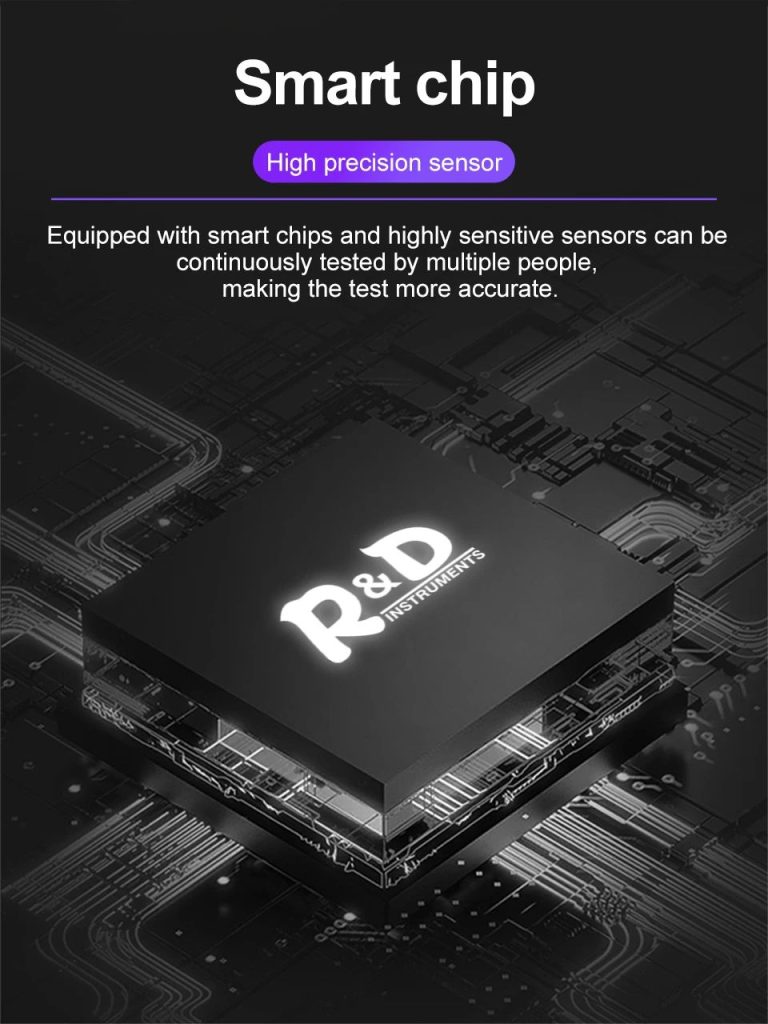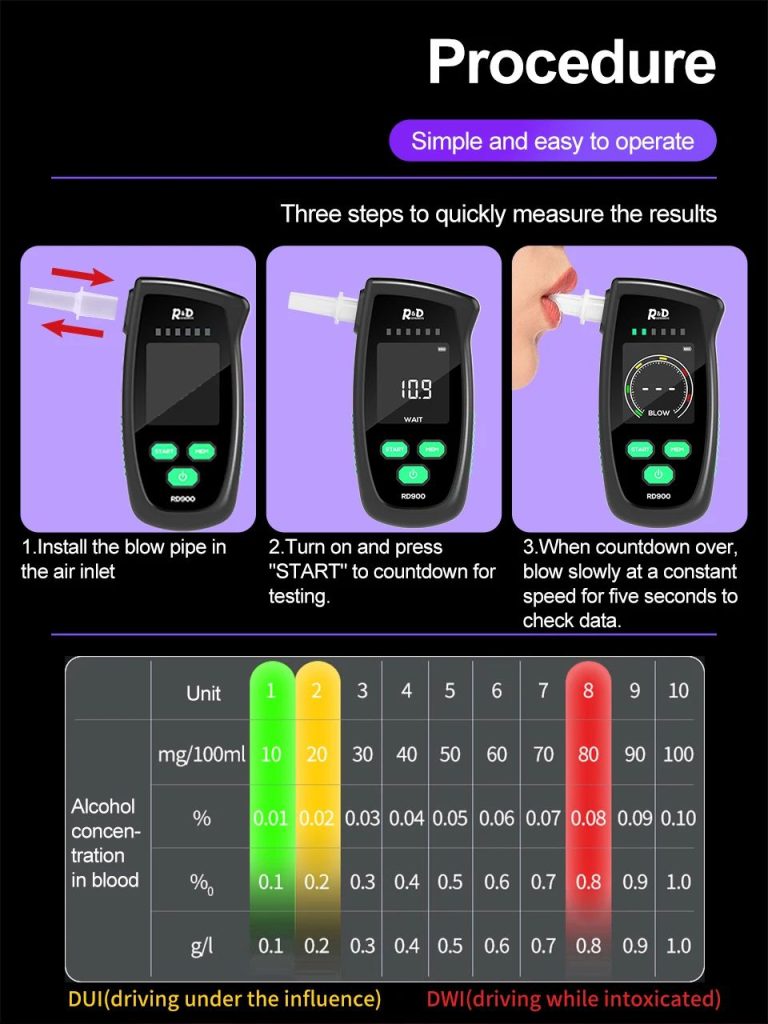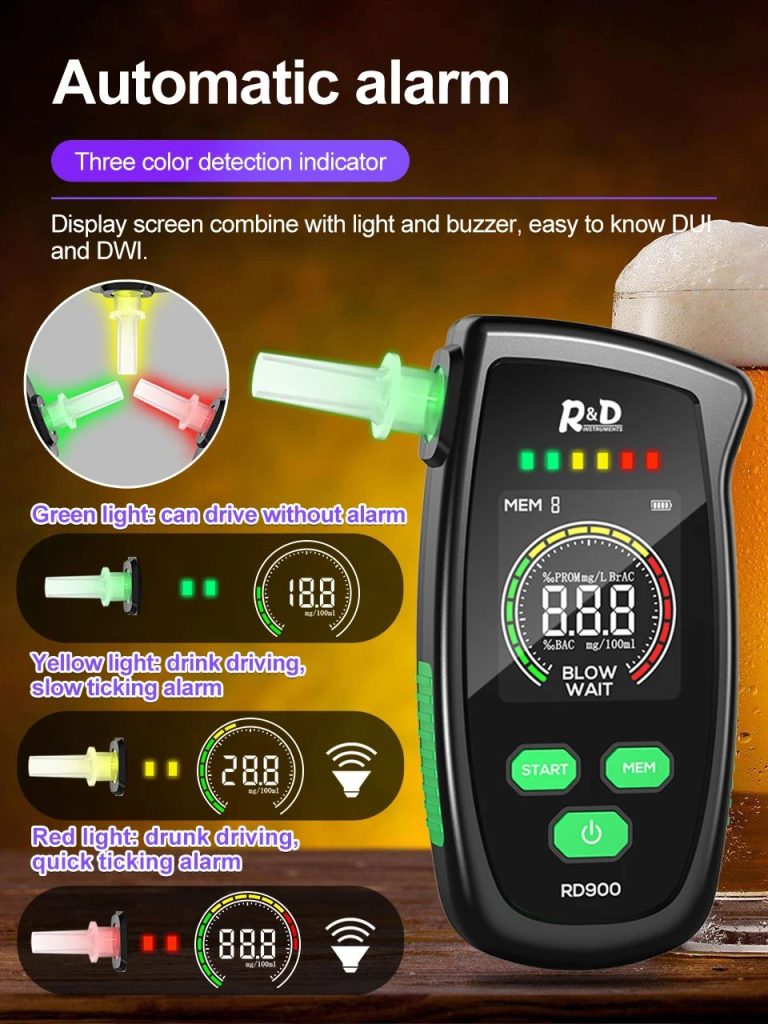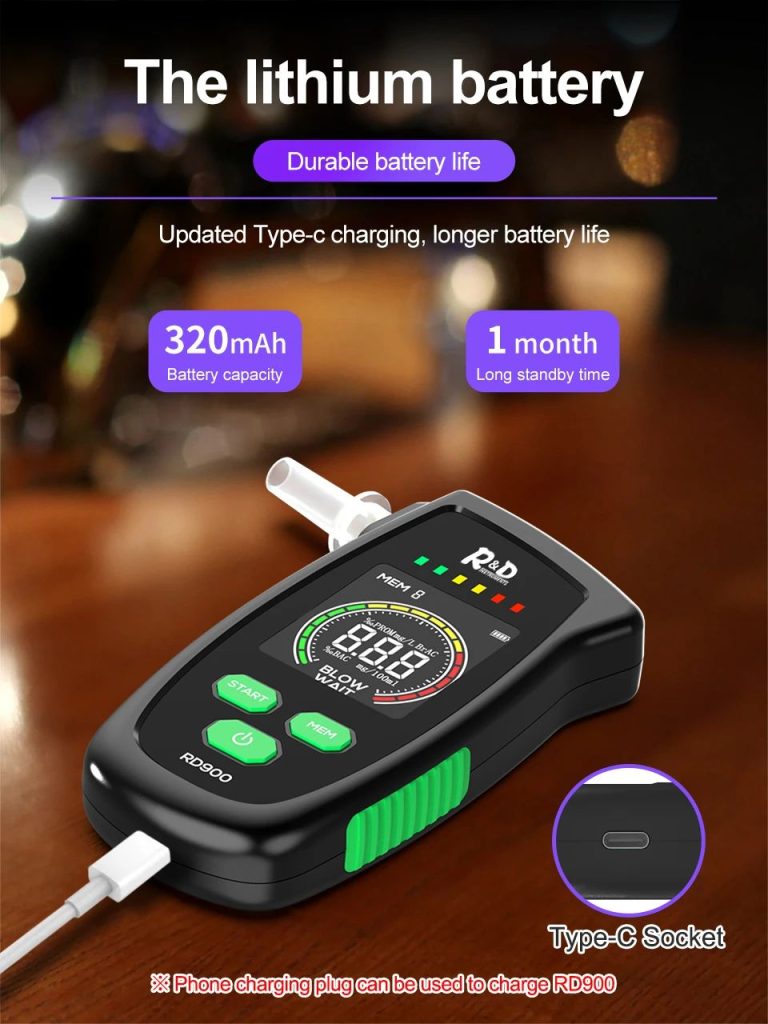
Radex Breathalyzers
- 3 in 1 Breathalyzer Test
- High Precision Accuracy
- No Calibration BAC Calculator
- Same Technology Used by Police
- DOT Approved Technology
- 5 Sanitary Mouth Pieces Included
- 2 Year Product Warranty
- Free Delivery
$69.95
Watch The Video For The Radex Breathalyzer
What Are Breathalyzers?
Alcohol entering your lungs evaporates into a gaseous vapor that can be detected by breath analyzers and turned into an accurate reading for your BAC (or blood-alcohol content). An impactful breath test may include factors like mouthwash and breath fresheners; metabolism and body type also have an impactful presence. Breathalyzers are devices designed to measure the alcohol content in someone’s breath. It does this using semiconductor oxide sensors, fuel cell technology or infrared spectroscopy in order to detect ethanol (alcohol) present and convert its presence into a blood alcohol concentration reading.

Breathalyzers are widely utilized by law enforcement to measure drivers’ blood alcohol content. If tested positive, results of these tests could have serious legal repercussions if someone drives while under the influence. One way to help avoid these ramifications is being mindful with alcohol intake and refraining from intoxicants while driving.

If you want to pass a breath test quickly and easily, the easiest and best approach is to drink plenty of water and wait the necessary amount of time before taking a test. Also avoid alcohol-containing mouthwashes or breath fresheners and make sure you blow steadily and deeply until instructed to stop by blowing steadily into the device until instructed. Avoid any tricks to beat breath analyzers such as sucking on copper-coated coins, holding batteries under tongues, or chewing gum (as seen on TV shows and websites such as Manswers).

Breathalyzers are designed to detect the chemical ethanol present in breath. However, some medical products and mouthwashes contain other substances which could give rise to false positive results when tested against breathalyzers. If concerned, be sure to read labels carefully and consult a healthcare provider if there are any concerns over these medications’ potential impacts on breathalyzer results.

BAC Calculator
Modern breathalyzers use one of three methods in order to accurately calculate drivers’ blood alcohol concentration (BAC). The most widely type used method employs a semiconductor sensor, which detects the presence of ethanol by measuring the difference in color between samples in test chambers and reference chambers containing unreacted potassium dichromate solutions. As soon as ethanol interacts with this solution, its color changes from red-orange to green; quantified by this device. Once converted by microprocessor into quantitative values for BAC.

As its name implies, breathalyzers measure alcohol vapors in your breath to estimate your Blood Alcohol Content (BAC). Law enforcement officers administer this test when they suspect alcohol consumption. Once administered, the device calculates your BAC using how much ethanol has entered your system; its result will then be used to decide whether you are fit to drive or subject to legal consequences; in the United States this threshold stands at 0.08 (seen on roadside tests only). Consumer breathalyzers can also be found widely available both online or from specialty electronics stores.

How Does a Breathalyzer Test Work?
Breathalyzers typically come in three categories: semiconductor, platinum-ion and fuel cell devices. Platinum-ion breathalyzers use two platinum electrodes connected to an acid-electrolyte material inside a test chamber that reacts with alcohol molecules to generate an electric current that measures how much alcohol there is present; its internal computer then converts this reading into an estimated blood alcohol concentration (BAC).

The semiconductor breathalyzer is similar to its platinum-ion counterpart but utilizes semiconducting material instead of acid electrolytes for accurate results. It’s less costly and more suitable for home use; however, accuracy may be affected by factors like alcohol in the mouth or certain medications taken orally.

A semiconductor breathalyzer is an affordable and user-friendly breathalyzer designed to be portable, user friendly and some are low cost disposable types, typically found at some stores or available online. They’re typically capable of distinguishing between alcohol and other substances, reducing false positives; however, these breathalyzers may still be affected by other factors like mouthwash ingredients or chemicals that affect them.

Fuel cell breathalyzers like those used by law enforcement officers provide more precise results and are much more expensive. Equipped with two platinum electrodes and an electrolyte solution in between them, when an individual blows into this device the platinum electrodes oxidize alcohol vapors to form protons and electrons that combine with oxygen to form water; when more alcohol oxidization takes place the stronger its electric current becomes and its internal computer calculates these results into an estimated blood alcohol content estimate.



How Long Does a Breath Tester Last?
Breathalyzers measure alcohol content by analyzing the air that a person breathes, using either a semiconductor sensor or platinum fuel cell to analyze a sample of their breath and calculate BAC (blood alcohol content). Breath tests are fast, non-invasive, portable and widely used by police for checking BAC and legal applications alike; yet due to potential accuracy issues and their large margin for error they should be regularly calibrated to maintain accuracy and reliability.

A person’s Blood Alcohol Content (BAC) will depend on both the type of drink they consume and their individual metabolism. People who weigh more may have higher body mass index scores which affect how quickly alcohol spreads throughout their system. Furthermore, eating prior to or while drinking could alter test results significantly.

Breathalyzers remain one of the most frequently utilized devices for testing blood alcohol content (BAC). Law enforcement officers can utilize handheld breathalyzers while on patrol to quickly assess a suspect’s BAC level; larger and more reliable Evidential Breath Testing (EBT) machines provide more precise results in laboratory settings.

EBT machines can be more costly, requiring training to operate effectively. They’re designed to test for various factors which may cause false positives such as mouthwash or certain medications; temperature and humidity fluctuations could even play a factor.

Reliable Alcohol Tester
Breathalyzer readings require that individuals blow into the device while simultaneously holding their nose and exhaling hard. Readings will then be recorded as either zero, warning, pass or fail and those who failed may need to undergo further analysis at their local station

Most states make it illegal to drive with a blood alcohol content (BAC) level exceeding the 0.08% legal limit set by law enforcement agencies. If pulled over and breathalyzer results show your BAC level surpasses this legal threshold, you may be charged with driving under the influence (DUI). Anyone found guilty must install ignition interlock devices which prevent their car from starting if there’s alcohol present in their system.
Can You Get a Breathalyzer in A Car Installed in Your Car?
Breathalyzers can be an efficient tool for measuring alcohol in your bloodstream, but they aren’t infallible; many factors such as temperature, recent food or beverage intake and mouthwash use could skew test results negatively. Furthermore, in 2014 a study concluded that some personal breathalyzers aren’t accurate enough to determine whether it is safe to drive after indulging. Errors caused by intoxicated drivers can be life-threatening, and therefore it’s crucial that any device used be both reliable and easy to operate.
Those thinking about a in-car breathalyzer that offers reliability while remaining portable should consider an ignition interlock device (IID) also known as a baiid interlock device. IIDs are required for those convicted of DUI/DWI and connect directly to your car’s ignition system to require blowing into a mouthpiece before starting the car; those failing their breath test will be prevented from driving for a set period or until providing a clean sample from which.
A high-quality breathalyzer will feature something called a fuel sensor. These sensors are capable of detecting low levels of alcohol using an electrode specific to alcohol-oxidation reactions to measure how quickly it converts to acetaldehyde and produce an electrical current proportional to the amount present; typically found at police stations. Separate semiconductor gas sensors measure increases in conductance due to alcohol vaporizing on an oxide layer; cheaper breath testers often include these types of sensors as well.
Radex breathalyzers are designed to detect these differences accurately, although even they have their limits; even the best devices cannot provide 100% accurate readings due to factors like age, gender, rate of consumption and medications which could influence results. Therefore, it is wise to plan ahead by making alternative arrangements like hiring a designated driver before getting behind the wheel after drinking alcohol.
How Breathalyzers Help Prevent Accidents
Breathalyzers detect alcohol molecules exhaled from exhaled air. Utilizing fuel cell technology, semiconductor oxide sensors or infrared spectroscopy, these devices generate an electrical current proportional to the presence of ethanol molecules.
Law enforcement officials may use these devices at DUI checkpoints or when testing for suspected drunk drivers, encouraging responsible alcohol consumption and making driving safer for everyone on the road.
Detects Alcohol in Your Breath
At the core of every breathalyzer lies its sensor module, which uses sophisticated technology to detect alcohol molecules in breath samples. Older devices pass them through potassium dichromate which converts ethanol to acetic acid and produces an identifiable color change detected by monochromatic light beam. After sensing is complete, a microprocessor then converts this sensor signal into blood alcohol content (BAC) reading displayed on its display screen.
More advanced devices use fuel cell technology to detect breath alcohol concentration by measuring electric current strength and converting that measurement into a blood alcohol content reading. These new devices are much simpler and user-friendly than Robert Borkenstein’s PBT device that first emerged in 1954. Modern breathalyzers measure blood alcohol content (BAC) using chemical reactions. When you breathe into the device, ethanol in your breath is measured to estimate your BAC. Depending on its type, breathalyzers may detect alcohol through fuel cell sensors or infrared spectroscopy; Smart Start uses both of these technologies in their ignition interlock devices and portable breathalyzers.
Devices administered by law enforcement to check that drivers do not exceed the legal limit for driving can also provide accurate readings; disposable home BAC test kits may offer less reliable results – even just 10% error can have serious repercussions should erroneous readings lead someone behind the wheel without making necessary arrangements for safe transportation home. It is wiser to consume alcohol responsibly and arrange safe ways of returning home after drinking responsibly.
Prevents Car Accidents
As more states implement laws mandating interlock devices as punishment for DUI offenses, alcohol-related crash deaths could drop by as much as 25% and save over 9,000 lives per year, according to research from the Insurance Institute for Highway Safety. Breathalyzers not only act as deterrents against drunk driving, they also ensure that only sober people drive by checking their blood alcohol concentration levels – increasing overall road safety for everyone involved.
Baiid Interlock Devices
However, certain breathalyzers such as a baiid interlock device, require drivers to blow into them while driving, making them potentially distracting and even dangerous. A recent review by The New York Times of accident reports and lawsuits uncovered numerous instances in which drivers attempting a rolling retest caused serious collisions while trying to take an official rolling retest test.
Reduces Car Insurance Rates
Breath tests are one way of demonstrating your innocence when driving drunk, but the most effective way to reduce insurance rates after being charged with DUI is maintaining a clean record and enrolling in driving safety classes to show commitment to safe driving practices.
Refusing The Breath Tester
Some may be tempted to decline a breath test, but that can have dire repercussions. While disposable BAC testers can have error rates up to 10%, most are accurate enough to detect alcohol in your system so you can decide whether or not to drive. Ignition interlock devices (a type of breathalyzer wired into cars of convicted drunk drivers) have been estimated to save lives by decreasing repeat drunk driving incidents by 65-75%. Sometimes disposable types of breathalyzers are used by law enforcement officers to measure drivers’ blood alcohol concentration (BAC), are also available as single-use breath tests that individuals can use at home.
Drunk driving is a leading cause of accidents on our roads, and decreasing its prevalence could save lives. One effective strategy to do just this is requiring drivers to install ignition interlock devices in their cars.
These devices prevent cars from starting if the driver blows into them while under the influence of alcohol. Numerous online retailers sell breathalyzers; it is wise to research models based on price, accuracy and customer reviews before purchasing one. A good breathalyzer should detect ethanol-containing beverages.
Should Bars And Restaurants Have Breathalyzers?
Every day in the U.S., nearly 30 people die due to motor vehicle crashes involving drivers who were under the influence of alcohol, making this statistic alarming and any business serving alcohol has an obligation and responsibility towards society to implement measures that discourage drunk driving, including providing breathalyzers in its establishments.
Breathalyzer In A Car
Breathalyzers are widely available as handheld devices that enable individuals to test their blood alcohol level; businesses, however, can purchase larger commercial breathalyzer machines similar to those used by law enforcement and also similar to a installed breathalyzer in a car. Usually larger and countertop-mounted, these commercial breathalyzers feature coin or bill acceptors to activate them after someone swipes their credit card then blows into a disposable straw to activate it; giving a readout of blood alcohol content (BAC).
Some companies provide breathalyzer vending machines in bars, stadiums, convention centers and fraternity houses that serve alcohol. You can purchase one for an upfront cost and each time it is used the company will collect a portion. Other firms take an in-depth approach by sending trained breath testers directly into bars they work with to train staff members how best to utilize this equipment.
Breathalyzers may seem inaccurate to some, yet law enforcement and private companies rely heavily on them when testing drivers for DUIs. A recent survey conducted by one breathalyzer manufacturer revealed that 68% of respondents felt bars and restaurants with liquor licenses should keep breathalyzers readily available for patrons.
Concerns among businesses when installing breathalyzers at their locations is that their liability could be held accountable if someone uses them to determine they have exceeded the legal driving limit. However, this risk can be reduced by restricting its usage to medical related purposes only.
Concerns surrounding breathalyzers include their cost and need to regularly calibrate and maintain them, which can quickly add up over time. Furthermore, businesses fear their liability insurance rates will increase if they have breathalyzers installed; this isn’t always the case however as many insurance providers offer specific guidelines covering usage by certified technicians in certain locations – sometimes offering discounts as an incentive!
At its core, having a breathalyzer in some types of businesses will help decrease the number of drunk drivers on the roads – something which benefits everyone involved. Training or awareness alone won’t completely eradicate drunk driving accidents and deaths – any tool which encourages people to think twice before drinking and driving is welcomed and especially with strict new DUI laws being passed every year, now is an opportune moment to take every possible measure to keep customers safe.
Portable Digital Alcohol Breath Tester’s Can Save Lives
Digital alcohol breath testers can help prevent drink driving and road accidents by measuring the concentration of alcohol in your breath and displaying it on a screen. Easy and accurate, digital breath analyzers allow users to stay under their legal drinking limit and avoid expensive fines while being far more cost-effective than professional devices used by police officers.
Portable breathalyzers make measuring blood alcohol content (BAC) effortless: just switch it on, wait for it to warm up, blow into its mouthpiece, and allow the device to run up to 20 seconds (depending on its model) so the sensor gets an accurate sample from deep lung tissue. Furthermore, ensure the device is stored away from smoke or any other source of contaminants to ensure accuracy.
The breathalyzer will then display the results on its LCD screen and indicate your level of intoxication through various color codes: green for below the legal driving limit; red means above; yellow or orange indicate excessive inebriation.
Breath tests may be the simplest and quickest way to check your BAC, but they may not always provide accurate results if certain substances were consumed prior to taking it – for instance, mouthwash can distort its accuracy and impair reading accuracy on breathalyzers. Therefore, before using this device it is wise to read its instructions thoroughly first.
Court Ordered Portable Alcohol Monitoring Device
If you are charged with driving while intoxicated or any offense involving alcohol, such as domestic violence or DUI, a portable alcohol monitoring device may be imposed as conditions of bond. These devices monitor breath samples to test your alcohol consumption; often these conditions of bond are included for DUI cases or offenses that involve alcohol consumption and help courts ensure that an individual doesn’t consume while on bond and may help deter future offenses involving it.
Radex Baiid devices are popular choices among many monitoring agencies for alcohol violations. These handheld breathalyzers require defendants to blow into them several times daily in order to detect alcohol consumption; additionally, this model includes a camera which allows agencies to verify it’s really them who is blowing into the device.
A device will report back a pass/fail status to the agency and can provide an account of activity of the Defendant, including whether or not they attempt to remove or circumvent it. Failing a test or trying to remove it is considered a breach of bond and could result in jail time.
Judges often order certain devices such as an Ignition Interlock Device or SCRAM device when they believe a defendant does not understand why they cannot drink alcohol, leading them to jail. If an individual cannot refrain from drinking despite knowing it will result in jail, this may indicate alcoholism that needs treatment.
